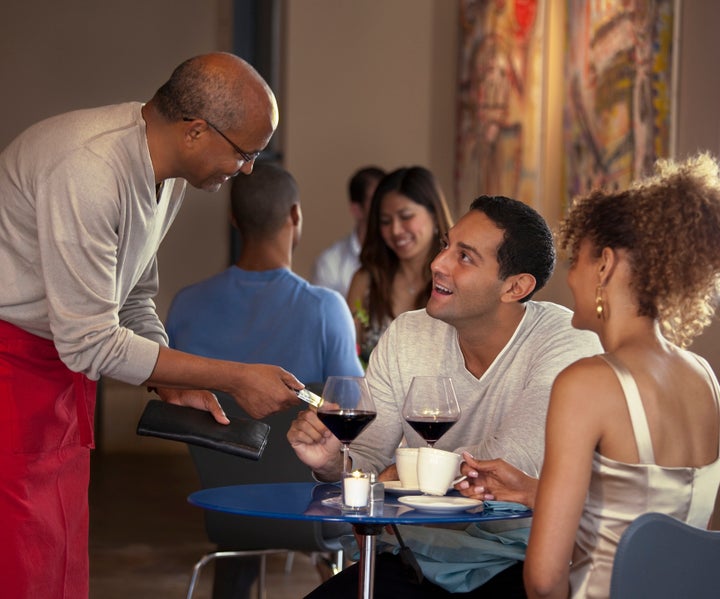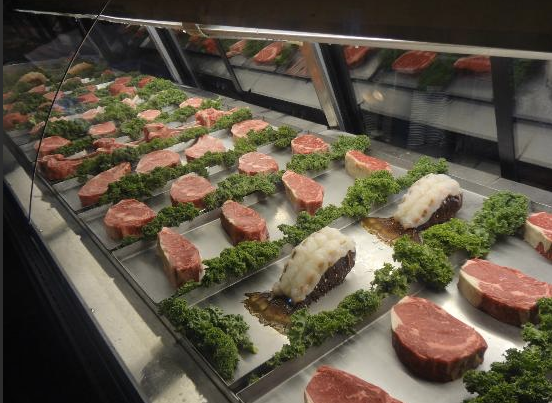
In response to a handful of new city and state laws raising minimum wages to $12 or $15 per hour over the next few years, forward-thinking restaurant owners are trying to get ahead of the changes by paying all workers more now. And to do that, some of them have chosen to completely eliminate tips in favor of raising menu prices or instituting a flat service fee charge.
The changes are working out for some restaurants better than others. Upscale restaurants like Pittsburgh's Bar Marco and The Livermore have just celebrated one year of getting rid of tips in favor of higher menu prices that fund salaries and paid vacations for workers, reports the Pittsburgh Post-Gazette.
But sister eateries Arc and Restaurant Marin in Costa Mesa, California, had to end their no-tipping experiment in June after just two months of higher menu prices, reports the Orange County Register. Chef-owner Noah Blöm told the paper that higher menu prices were alienating diners, and that his restaurants may have been "ahead of the curve" when it came to a no-tipping system.
There are a lot of arguments against our current tipping system: As Tom Colicchio, David Chang and other prominent chefs have pointed out, raising menu prices or instituting a flat service charge is a better way to distribute money between restaurant workers. Getting rid of tipping also eliminates consumer confusion about how much to tip, as well as protects workers from bad tips.
But despite these advantages, some restaurants that embark on temporary experiments end up reverting back to the old system. This may be because tipping, at this point a centuries-old American tradition, offers customers a subliminal psychological boost that keeps them attached to the old way of doing things.
Michael Lynn of the Cornell University School of Hotel Administration worked for tips as a busboy, bartender and waiter before going on to research the service industry, and tipping in particular, for over 30 years. He recently released a Center for Hospitality research report on the arguments for and against our optional gratuity system, and explained to The Huffington Post that there are many layers to the psychological benefits tipping offers diners.
Tipping gives people an illusion of control.
Joe’s Crab Shack was the first national chain to try increasing the price of menu items in order to do away with the tipline. The company announced in May they would scale back the changes from 18 restaurants to four in response to declining revenue. CEO Bob Merritt explained that customers wanted to maintain some way to incentivize service over the quality of the service, reports Nation’s Restaurant News.
Like Joe’s Crab Shack customers, the majority of participants in research about tipping say they prefer the current tipping tradition of voluntary but expected percentages of the total bill. They believe it incentivizes better service, and this better service in turn leads to a better experience at the restaurant.
But Lynn notes that this “control” is rarely exercised; average tipping percentages are only very weakly linked with the quality of service overall. Because of this, Lynn suspects that this narrative about “control” may in fact may be a convenient fiction that restaurant patrons tell themselves when they say they like tipping.
“People tip out of a sense of social obligation, but they don’t want to admit that’s why they tip, even to themselves,” Lynn said. "[Incentivizing service is] literally a story they make up to explain their behavior, and that story influences their rated liking for the custom and doesn’t really alter the fact that they don’t really get anything out of it.”
Automatic service charges trigger an aversion to being told what to do.
Travis Kukull, chef and owner of the Seattle restaurant Mollusk, tried to do away with tipping by installing a flat 20 percent service charge for all bills when his restaurant opened back in 2015. But in an interview with the Seattle Times in January, he announced a return to tipping, explaining that the restaurant was “not busy enough yet for it to make sense.”
The failure of the flat service charge at this Seattle restaurant aligns with the findings in Lynn's research report: Flat service charges are American diners’ least-favorite restaurant pricing model, despite the fact that they are standard in restaurants around the globe.
"The problem is that the service charge is so similar to a tip except that it’s mandatory, and the mandatory component irritates people,” Lynn explained. What makes the aversion stronger, he suspects, is that American diners are used to the perception -- however specious -- that tipping is optional.
A menu that doesn't account for full staff costs creates the perception of lower prices.
While there are so many reasons tipping is a headache for restaurant owners, the truth is that tipping also plays a psychological trick on customers by making it easier for them to view a restaurant as less expensive than it truly is. This is the biggest reason some restaurants should stick with the current tipping system, Lynn writes in his report.
Separating charges out into components on the receipt, instead of presenting it as one single number, prevents customers from fully processing the total amount and instead makes them focus on the most expensive charges. This allows consumers to treat the tip separately from menu prices, and to think of the restaurant’s overall expense in terms of menu item prices only.
Secondly, the tipping systems allows big tippers to subsidize, or make up for, the smaller tips of customers who may be poorer or more price-sensitive. Instituting a flat service charge would be a shock to small tippers that now have to pay more, and this in turn would cause them to visit the restaurant less.
Interestingly, Lynn found that a flat service charge would make no positive difference to big tippers who are richer and less price-sensitive -- even if they pay less with the service charge than they do with their normal tip. And these richer diners probably wouldn’t return to the restaurant often enough to make up for the loss of the small-tippers.
Tipping gives people the nice feeling that they're helping others.
There’s a whole lot of research that shows helping others helps you feel good, too. This “helper’s high” might be motivating some tippers, especially since a tip isn’t technically required and it’s legal for businesses to pay tipped workers as little as $2.13 an hour in 17 states.
"There are people who say say, ‘Yeah, I tip in order to make up for poor wages,' and those people tend to tip more than others,” said Lynn. “Absolutely, that is part of at least some consumers’ thinking and motivation behind tipping."
But before you start patting yourself on the back for your "charitable" tips, Lynn's research also shows that racist and sexist unconscious biases can also creep into the amount of money diners chose to leave. Black waiters earn less tips than their white colleagues regardless of the quality of service, and slender blonde women with larger breasts earn more tips than others who weigh more. In other words, you might be feeling more generous to certain types of servers without really knowing why, and these hidden forces make servers more vulnerable to sexual harassment and racial discrimination.
Another unflattering explanation for the warm fuzzy feelings produced by tipping comes from a study Lynn conducted that found people who are more comfortable with hierarchies and power disparities were more likely to tip, which suggests that tipping is a way to reinforce one's power over a server.
So does this mean that tipping is here to stay, and there’s nothing American restaurant owners can do about it?
Not necessarily, says Lynn. His research shows that upscale, expensive restaurants -- where the customers trend rich and there’s a big pay disparity between waitstaff and back-of-the-house employees -- should probably consider replacing tipping with a different price model. This is primarily because for these restaurants, tipping takes money that should be going to the restaurant to be spread out among more workers and gives it to servers "in the form of excessively high tip income.” Upscale New York restaurateur Danny Meyer, who eliminated tipping from all 13 of his full service restaurants in 2015, provides a good example of this.
For businesses who can get their customers to buy into the no-tipping model, it's clear that the system pays higher wages for all restaurant workers as a whole. But Lynn admits he is less confident about how the data stacks up when it comes to tipping’s effect on customers.
He waffles over whether tipping ultimately benefits those who tip, or whether it's simply a social norm that pressures people into doing something they don't want to do. One intriguing thought experiment makes him suspect that tipping is a net negative: When an American diner travels to a country where tipping is not customary, do they value the psychological benefits of tipping so much that they pay their customary tipping percentage, even though it isn’t expected of them?
Lynn's own personal experience suggests that most wouldn’t bother. For instance, when he went to Australia, where tipping is not a social norm, Lynn did not tip.
"If I got something out of tipping waiters [in the U.S.], I’d get that same personal satisfaction from tipping Australian waiters,” he explained. "What’s different is it’s expected here, and if I don’t do it I’ll get in trouble, but in Australia it’s not expected."
